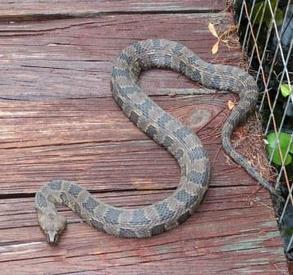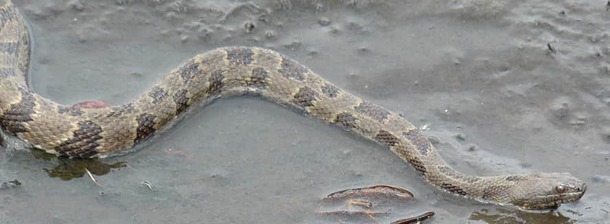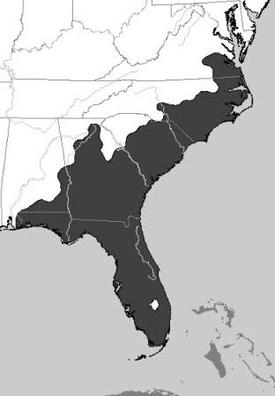Brown Water SnakeNerodia fasciata |

Custom Search
|
These snakes are also one of the most common Florida snakes, living alongside some infamous invasive snake species like the burmese python (Python bivittatus) or the reticulated python (Malayopython reticulatus).
These semi-aquatic snakes may be found in a variety of flowing water aquatic habitats. They commonly inhabit lakes, rivers, ponds, streams, blackwater cypress swamps and waterways, canals and drainage ditches. Brown water snakes are also common around sawgrass prairies, bottomland forests and margins of brackish tidal marshes.They are especially fond of habitats where overhanging vegetation can be found, but also emergent snags, or rocky river banks where they may bask in the sun. Usually found from sea level up to 500 feet (150 m) of altitude. They are less prone to travel over land than other watersnake species for that reason the brown water snake is seldom found far from the edge of the water. They usually bask during the daytime on tree branches and vegetation overhanging the water, sometimes as high as 20 ft above the water. If threatened they will just fall into the water to escape, this means that sometimes they land on a boat of an innocent fisherman. If captured, the brown water snake, will bite repeatedly and emit a nasty smelling musk in its attempt to escape. The brown water snake is a large fairly heavy-bodied semi-aquatic snake species with a large head much wider than the neck. It ranges in length from 28 to 69 inches (71 to 175 cm), with females being larger than males. Much like crocodiles and alligators both their eyes and nostrils are located at the top of the head, enabling these snakes to easily breath and see on the surface of the water. The brown watersnake has strongly keeled scales with 25 to 33 dorsal scale rows at midbody and a divided anal plate.

Like the name indicates the brown water snake colors range from light to dark brown. Down its back it as a row of large blackish or darker brown square blotches which alternate with rows of blotches on each side of the body. Their belly color is usually light yellow to brown marked with black or dark brown splotches and black crescents.
Due to their habitat, color, pattern and somewhat triangular shaped head, the brown water snake is often mistaken for the venomous cottonmouth or water moccasin (Agkistrodon piscivorus). This misidentification leads the killing of many of these and also other harmless water snakes. The species is also known by other common names including false moccasin, pied water snake, southern water snake, aspic, water-pilot, great water snake and water rattler. This north American species is not to be confused with the South African common brown water snake (Lycodonomorphus rufulus), which are also sometimes called brown water snake. Diet / Feeding The brown water snake feeds primarily on fish, particularly juvenile catfish, it's a piscivorous species. These snakes have been seen with catfish spines sticking out from their bodies, these will eventually break off and the snake recovers. But will also eat minnows, frogs and even other snakes. They are excellent swimmers and actively forage underwater rocks, debris, and vegetation in the bottom or edges of rivers and lakes. They are also ambush hunters waiting until a fish comes within striking range, they catch it and swallow it alive. The brown water snake has other rather unique hunting method, being great climbers they will hang from tree branches over aquatic prey like frogs and capture them from above. Due to their weight gravid females have limited hunting strategies available to them and may take on scavenging. Reproduction The brown water snake is ovoviviparous, meaning females carry their eggs internally up to the time the neonates are ready to hatch. Mating season occurs during spring, between late February and early May. It often takes place in branches of low-hanging trees. The males follow scent trails left by females to track them, sometimes several males may find and try to mate with one female. They don't have a set gestation period, because female ovulation is the factor that determines when they get pregnant. Females sometimes store viable sperm for months or even years in their cloaca. In order to become pregnant females will first need to increase their body fat reserves to ovulate. This is why brown water snake females are larger and heavier than males. All that extra body fat will be used to produce egg yolks, to nurture the baby snakes while they develop inside the mother's body. They give birth to 14 up to 60 neonates per clutch in the late summer, from June through November, but usually during August.The hatchlings range in length from 7 to 11 inches (18 to 28 cm), they resemble their parents but their colors are brighter. Conservation / Threats These are fairly abundant snakes, and in their favorite aquatic habitats, several can be seen in a short period of time in just a small area. However, ignorance leads to the killing of many harmless water snakes, because like other water snake species, they are often mistaken for other more dangerous venomous snakes. The brown water snake is classified as a "Least Concern" species by the IUCN.
|
Scientific Classification |
© 2014 Snake Facts About Us | Privacy Policy | Contact




